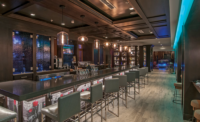Creative structural design and engineering has been essential in transforming a nearly 150-year-old former orphanage into a 74-room boutique hotel in the Lower Garden District of New Orleans. The $22.5-million Hotel St. Vincent project is nearing completion.
The restoration called for completely gutting, renovating and converting the property’s five historically designated buildings to create a 71,500-sq-ft luxury hotel with a newly constructed 6,000-sq-ft event space and private verandas for each room.
The buildings date back to the late 1800s, when they housed the St. Vincent’s Infant Asylum. The project team had to reengineer the load-bearing masonry building envelope, restore historic details and manage all of the logistical complexities that come with restoring a 19th-century property.
With so many moving parts, historic restorations like the St. Vincent project can involve 50 to 75 professionals before a shovel ever hits the ground, says Nicholas Moldaner, project executive for general contractor Palmisano, which specializes in historic hotel projects.
“Historic, boutique hospitality projects are one of the most complex project types in the commercial design and construction industry,” Moldaner says. “The physical constraints and deteriorating conditions of a historic structure, combined with the goal of creating a one-off guest experience, creates an extraordinary level of collaboration across a large and diverse project team.”
The project team includes multiple New Orleans-based firms: Palmisano as the design-assist contractor, architect MetroStudio, structural engineer PACE Group LLC, mechanical engineer EMB LLC and developer Kupperman Cos. Lambert McGuire Design of Austin is designing the project.
When complete, the St. Vincent will feature two restaurants, four bars, three commercial kitchens and a landscaped courtyard with a cabana, swimming pool and onsite parking.
Five buildings, one hotel
One of the more challenging aspects of the project is preserving the historic elements, says Ken Gowland, principal with MetroStudio. Three of the buildings were connected by a series of multistory galleries, and people would use the gallery balconies to walk from building to building. “Much of the original building circulation occurred on the exterior, so developing a new plan really forced some creative thinking,” Gowland says.
Through 3D modeling, the architectural team was able to map out the existing conditions at the outset of the project. The team then updated the model as needed throughout demolition and construction. They relied on these models to troubleshoot the restoration while keeping historic elements intact.
“Historic, boutique hospitality projects are one of the most complex project types in the commercial design and construction industry.”
—Nicholas Moldaner, Project Executive, Palmisano
The buildings’ interiors had been heavily modified over the years, and the campus had become rundown. But the two original grand staircases were largely intact. The team preserved these stairs and extended the staircase with a new matching portion between the third and fourth floors.
They also uncovered hidden, decorative cast-iron components, along with plaster and millwork details from the orphanage’s original chapel. The architect used salvaged components to recreate millwork details.
On the exterior, the team worked to salvage the French Quarter-style cast-iron exterior rails and balconies. The architect wanted to restore the cast iron in a way that made it stand out from the rest of the structure. “The nature of this material makes standard steel repair strategies almost useless,” says Brandon Stevens, senior architect with MetroStudio. “The architectural team developed a series of bespoke details to reinforce and repair these components that are basically invisible and allow the beauty of these details to come through.”
The project team preserved other exterior elements, including a gargoyle atop the clock tower and a marble header inscribed with “St. Vincent’s Infant Asylum” at the Magazine Street entrance to the property. Crews converted over 12,000 sq ft of exterior corridors into private verandas for each room. They also restored and reglazed all doors and windows and used French Quarter-style pavers throughout the property to complement the historic brick.
Engineering stronger walls
After a century and a half of aging and modifications, the St. Vincent buildings had deteriorated and needed extensive masonry repairs. Before any framing work could begin, the project team had to complete these numerous structural improvements. One of the primary challenges involved repairing the exterior clay masonry and other structural elements that date back to the 19th century.
“The building ... utilized not only heavy timber and load-bearing masonry but also built-up iron beams, cast-iron columns and an early version of cast-in-place concrete,” Stevens says. “We had to work with a variety of strategies to address structural repairs and load path modifications that worked with all these various systems.”
In working with a load-bearing masonry building envelope, moisture intrusion was a key concern. “These buildings are a real challenge, especially in hot, humid climates like New Orleans that have over 65 inches of rain a year,” Gowland says. “You pick up a whole slew of challenges when you bring modern cooling, ventilation and exhaust into buildings like these, where bulk water management and vapor drive pose extensive risk to the project performance.”
To repel moisture, the team repaired deficiencies on the exterior walls and introduced waterproofing details that fit into the historic aesthetic of the buildings.
The engineering and architectural teams performed an extensive analysis of the exterior masonry walls to determine how the existing walls would stand up to moisture and temperature changes. Early in the process, engineers created models of masonry conditions and simulated various climates to better understand how temperature and moisture flowed through the masonry over the course of a yearlong weather cycle. “This helped us anticipate some of the potential issues and informed our loading and fresh air requirements,” says Fletcher Luke, project engineer with EMB LLC.
To negate some of the moisture issues the engineers observed in their analysis, they installed dedicated outdoor air units to pressurize each building, Luke says.
PACE Group LLC, the structural engineer, also provided reality capture services including drone footage, laser scanning and Matterport scanning, which allowed stakeholders to start off with an accurate, as-built model, as well as a web-based platform to document, view and comment on structural repairs. One issue the architect and structural engineer discovered was that the property’s previous owners used incompatible portland mortar materials for masonry maintenance, and the use of these materials compromised the integrity of the masonry, Gowland says. “The architectural and structural team developed an extensive package of masonry fixes ... to address the broad range of challenges at the site,” he says.
Another structural concern was that the original buildings were set on soil-supported corbeled masonry footings, and introducing new loads could create settlement risks. “Piles and reinforced concrete grade beams and pile caps did not exist during the time of the original construction,” Gowland says. The architect worked with PACE Group to develop strategies to mitigate any risks, including an extensive stormwater management plan required by the city of New Orleans. Because the plan called for detaining stormwater onsite, PACE Group’s civil engineers helped develop a solution.
“This project required much creativity to solve the many structural issues the team discovered, such as new load pathing and restoring historic masonry load-bearing walls, but also developing a compliant stormwater management plan employing different strategies, such as TruGrid permeable paving, French drains and planter beds with MetroStudio and the landscape architect, VIDA, based in Costa Rica,” says PACE Group's Johann Palacios, civil and structural engineer of record.
Making room for utilities
The project’s heating, cooling and utilities systems required special considerations when it came to incorporating them into the historic structures. “In all cases, we had to be extremely mindful of impacts to the appearance of the building, noise issues and structural concerns,” Gowland says.
The owner’s specifications called for an HVAC system with variable refrigerant flow, or VRF technology. “While these systems are highly flexible, they do require an ample amount of real estate at building exteriors for the condensing gear,” Gowland says.
“In all cases, we had to be extremely mindful of impacts to the appearance of the building, noise issues and structural concerns.”
—Ken Gowland, Principal, MetroStudio
3D modeling was key to working out strategies for adding this infrastructure. “Having an evolved model let us look at these problems strategically and definitely assisted in communicating these construction requirements to the GC,” Gowland says.
The project’s engineering and architectural team spent nearly six months testing different strategies that would allow them to preserve the building’s historic appearance while incorporating utilities. “Space is always a premium on projects such as these, especially when you are integrating infrastructure into a building that never had it as part of its original program,” Luke says.
Based on past experience, the engineer determined it would be essential to design the project’s infrastructure early in the schematic design process so both designs could take place simultaneously. This would allow the engineer and architect to design around both sets of needs. “You can’t wait to bring these components in later,” Luke says. “The realities need to get in the plan on Day 1.”
Road to completion
Hotel St. Vincent’s rebirth is approaching the finish line after a series of events going back a decade, along with setbacks throughout 2020.
Developer Zach Kupperman saw the potential in the property when he first put in an offer in 2011. At the time, the St. Vincent was operating as a hostel known as the St. Vincent’s Guest House, and the owners were not yet ready to sell. Kupperman finally purchased the property in 2017 with a vision to transform it into a high-end neighborhood hotel.
In developing the project, Kupperman had to consider the character of the neighborhood along with the challenges of reconstructing deteriorated old buildings, and he attended 80 neighborhood association meetings to get the community’s buy-in.
“We didn’t want to do something the neighborhood didn’t want. So we spent a lot of time collaborating with the Lower Garden District Association,” he says.
A few months after construction began in September 2019, the project encountered staffing-related slowdowns and fabrication delays when the pandemic hit. Then the project faced site closures during the highly active 2020 hurricane season. Five storms made landfall in Louisiana but did not result in any physical damages to the project, Moldaner says.
Despite those setbacks, Kupperman is seeing his vision come to fruition. “For the most part, we’re on track for where we need to be,” he says.
The project team is completing final touches on the project in advance of the hotel’s scheduled opening in May.







Post a comment to this article
Report Abusive Comment